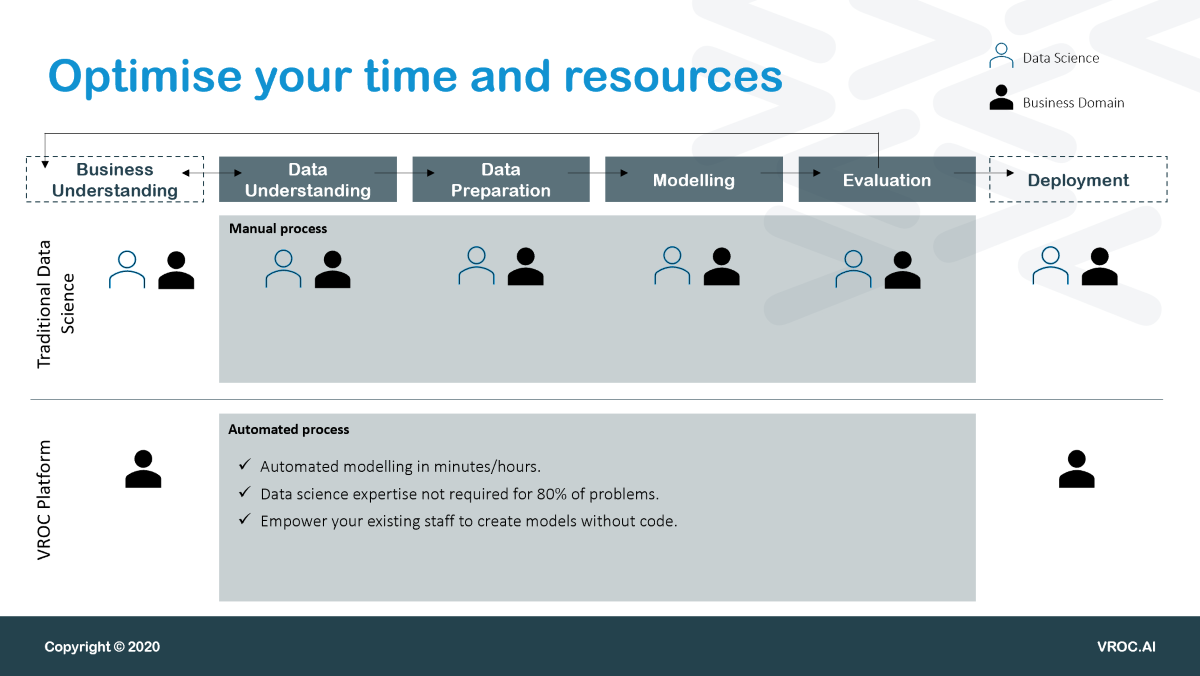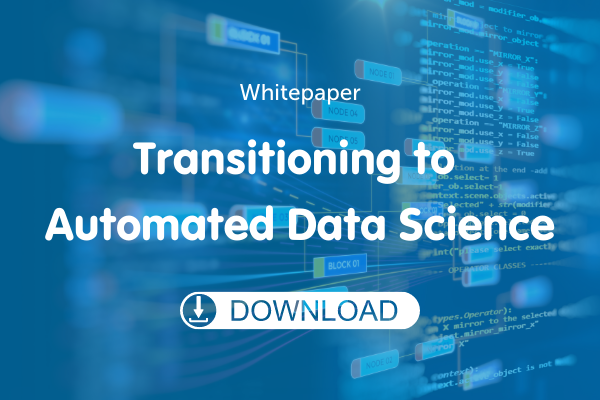It’s the elephant in the room. A problem that nearly every industrial business suffers with and doesn’t articulate. Whilst talking ‘digital transformation’, ‘industry 4.0’and ‘big data’ catch phrases amongst the C suite, on the ground there is little digital adoption.
Today there is a broad understanding of what artificial intelligence, auto machine learning and predictive analytics are, but there is still a lack of understanding of how it applies to and can benefit heavy industrial businesses like mining, power generation and oil and gas.
In the last 18 months we have seen a rise in the size of reliability teams, data science teams and on-the-ground maintenance teams. Some of whom sit around idle waiting for something to break-down. Reliability teams are over-stretched trying to keep sites operational and productive, often with little time to look at historic data, and past failures.
Data science teams (if they exist) know the value of the data from their assets. However typically these teams are working with traditional analysis methods, which take weeks if not months to determine the root cause of the problem, often to an 80 or 90% accuracy. With this level of accuracy, the problem is analysed from multiple different angles with the goal of 95-99% accuracy before presenting a possible root cause analysis to management.
Most equipment is now built as standard with sensors to capture data, but is this data being used? McKinsey reported that the mining industry uses less than 1% of their data to generate insights, whilst power plants use a mere 20-30% of their collected data to inform decision making. With companies either lacking the data infrastructure, management or analytics capabilities.
AI and data analytics tools have been in use across these industries for many years now, and during this time the cost of data storage and data analytics software has reduced significantly. The use cases for applying AI analytics is increasing daily with real value being attributed to the opportunities within process optimization, predictive maintenance, real-time remote monitoring.
In a recent Oil and Gas survey by EY they’ve found ‘Data and analytics are key to driving efficiency across the value chain. As an example, our estimates show an oil and gas company could potentially unlock more than US$145 million of value annually by integrating its key processes across the upstream oil and gas value chain with a common data model.’
It’s clear that the data is readily available, the overall cost is reducing, and the value proposition is strong.
There are several factors hindering data analytics adoption, and these vary company to company. However, we have found 4 common hindrances that all industrial businesses need to overcome.
The real opportunity from AI and advanced analytics comes when it is used to optimize processes and equipment on a continuous basis. Live monitoring of assets for example needs to be built into core processes. Auto Machine Learning software can provide teams with valuable real-time insights, that takes guesswork out of decision making and gives reliability teams confidence to act.
If teams’ comment that they are too busy for data analytics, then it is highly unlikely they haven’t tried to integrate it into their processes. They’ve approached the technology as an additional item to check-off their already busy list. Not realising it is a tool which should make their job easier.
Integrating any new software or technology into a process should be planned before attempting implementation. How can it be used in the existing process, or does the current process need re-designing? There are many processes that exist because ‘that’s the way we’ve always done it’ or due to inherit industry specific legacy systems, whereas there are now faster, more accurate methods.
AI Predictive analytics can give deviation alerts to control teams days or weeks in advance of potential failures. Incorporating these alerts into core process can ensure they are investigated early-on so that maintenance can be planned, and spare parts ordered. Adapting processes to benefit from technology, in this instance may eliminate unplanned shutdowns. EY has reported ‘an oil and gas company, on average, faces nearly 27 days of unplanned downtime annually, amounting to losses of nearly US$38 million to US$88 million.’
With the global economy back to levels of the Great Depression, the ability to reduce downtime and avoid un-necessary losses must be prioritised, and therefore processes must adapt for new technology.
Globally we have seen a significant skills shortage in areas such as data science, data engineering, artificial intelligence and analytics. This skills shortage has been commonly reported since 2018. EY’s report lists data analytics skills importance at 91%, however the current maturity in this space is estimated only to be 32%.
Companies can do their best to attract these essential workers through high salaries and other incentives however they also need to look internally at up-skilling. Thankfully the AutoAI and AutoML capabilities of analytics software has been developed and is assisting in data science democratization. Companies can empower existing business domain experts with tools to run their own AI models, reducing the reliance on data science personnel.
Domain experts have an advantage of understanding the business and its nuances, they can translate findings and analytics in a manner that can resonate with management and identify value opportunities. This can remove the reliance on specialist resources, and free them up to do complex problem solving better suited to their skill set. 
As businesses understand the opportunity that can arise from embedding data analytics into their processes and core framework, true digitalization will take place. The opportunities that exist from un-tapped data are countless, with companies looking at millions if not billions of dollars in savings opportunities from cost avoidance, improved sustainability, increased safety, operational reliability, decreased maintenance costs, optimized workforces, as well as increased production when data analytics is implemented enterprise wide.
This principal needs to be translated to middle and lower management, with KPI’s changed to include measurements of optimization, reliability and sustainability from data-led insights. Businesses can centralise the way they use data and share learnings amongst operating teams. Businesses that can build a culture which embraces data, understand its value and are not intimidated by technology, are businesses that rebound and outperform their competitors.
Whilst digital transformation is still on the radar for some companies in 2020, the COVID-19 pandemic has put it on the backburner for a great number. Mass redundancies, restructuring and a shifting of business-critical priorities has become the norm. Some industries such as oil and gas are also under pressure to decarbonise and meet net zero emission requirements.
Whilst some companies are still in the depths of despair, others have used this time as an opportunity to fast-pace their digital adoption, seeing the opportunity of technology, such as data analytics, to improve efficiencies. Such efficiencies are necessary for them to remain competitive both now and into the future.
Whatever the hindrance, for industrial businesses to grow in strength and resilience they need to find a way to move from mere ‘talk’ to implementation. Removing silos, increasing training in AI and analytics, doing away with un-necessary tasks for more data driven processes and giving data analytics the prioritization necessary to deliver real results.
Because you know what they say, you are ‘never too busy for data analytics’.
Get in touch with our team for assistance with overcoming your data analysis challenges or download our whitepaper ‘Accelerating Industrial Analytics Post Pandemic‘ today.
References:
5. https://assets.ey.com/content/dam/ey-sites/ey-com/en_gl/topics/oil-and-gas/ey-oil-and-gas-digital-transformation-and-the-workforce-survey-2020.pdf 
How to confidently move from pilot to enterprise-wide AI adoption
Read ArticleLearn how Industrial AI delivers tangible ROI in maintenance, operations and efficiency—an executive’s guide to evaluating AI investment
Read ArticleInterested in a demo of one of our data solution products?
DataHUB4.0 is our enterprise data historian solution, OPUS is our Auto AI platform and OASIS is our remote control solution for Smart Cities and Facilities.
Book your demo with our team today!
Complete the form below and we’ll connect you with the right VROC expert to discuss your project. Whether you’re launching a pilot, scaling AI across your enterprise, or integrating complex systems, we’ll help you turn your data into actionable insights—fast, efficiently, and with confidence.
The efficient deployment, continuous retraining of models with live data and monitoring of model accuracy falls under the categorisation called MLOps. As businesses have hundreds and even.
Learn more about DataHUB+, VROC's enterprise data historian and visualization platform. Complete the form to download the product sheet.
Learn how OASIS unifies your systems, streams real-time data, and gives you full control of your smart facility—remotely and efficiently. Complete the form to access the product sheet.
Discover how OPUS, VROC’s no-code Industrial AI platform, turns your operational data into actionable insights. Complete the form below to access the product sheet and learn how you can predict failures, optimise processes, and accelerate AI adoption across your facility.
Interested in reading the technical case studies? Complete the form and our team will be in touch with you.
Subscribe to our newsletter for quarterly VROC updates and industry news.